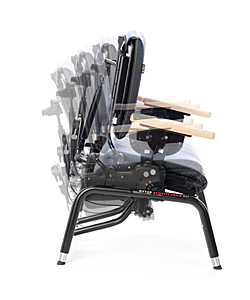
Children with an autism spectrum disorder find it difficult to focus. And when a child’s autism manifests in combination with profound mental retardation or with a developmental syndrome with physical limitations the difficulties with social interaction and attention to task are compounded. For the special education teacher, having children with autism in the classroom is challenging.
The constant need for movement sensory input as well as the presence of decreased (or increased) muscle tone often results in adverse responses by the student toward sitting. As classroom staff well know, repetitive fidgeting, rocking, slouching, or sliding off the chair are typical behaviors for the student with autism. Could the right seating make the difference?
Teacher and therapist experience has shown the Rifton Autism Chair (or stationary base chair) with its dynamic spring option, to be a successful choice for children with autism. Proprioceptive nerves in the muscles, tendons, and joints communicate to the brain where the body is in space and how it is moving. Children with autism or with attention or sensory-related disorders have found that the stimulation provided through movement helps them to remain in place and attentive during activities such as story-time.
More Than a Stationary Chair
The optional springs on the Rifton Autism Chair allow the backrest to “give” with extension pressure, and/or the seat to “rock” depending on the settings of the spring columns. These can easily be set into either the locked or unlocked position. When unlocked to allow movement, the sensory input can have a calming effect for children with autism.
The sensory input received by the student through repetitive bouncing while seated can help promote focus and may alter muscle tone. The frequent postural adjustments may potentially strengthen the core abdominal and trunk muscles, which in turn can promote better motor control for upper extremity use. Listening to a story or playing with squeeze toys are activities for children with autism that can be combined with the rocking motion. Children who need a sensory break may benefit from rocking in a Rifton Activity Chair while in a quiet area, to calm down and regroup.
It is always important to remember that for children with autism activities that are simple for other students can be complex or wearisome or both. Children with autism use their minds and bodies in a unique manner. Therefore traditional furniture is sometimes inappropriate.
More than one option for adaptive seating for children with autism should be explored in order to find the right one for each child. Recognizing the unique needs and challenges of students with autism enables classroom teachers and therapists to provide alternatives that can make or break the educational experience for the child.
The Rifton Autism Chair is designed to withstand repeated stress on the frame, and the result is a sturdy, heavier chair that will not move along the floor with the student’s movement. The accessories are optional, allowing for fewer parts to fiddle with or destroy. The design lends itself to the classroom; it fits in without looking “adaptive” and places students at the level of their peers.
Features of particular interest for children with autism include the Dynamic Spring and the Rifton Activity Chair Lumbar and Seat Support Kit. Placing the seat support securely beneath the seat pad to form an ischial shelf will help prevent the child with autism from sliding forward on the seat.